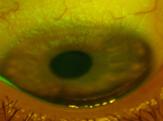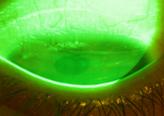This routine fitting of a low myope highlights some aspects of silicon hydrogel lenses (SiHy) which sometimes makes them a little unpredictable. Like a lot of practitioners, I have found SiHy lenses to be invaluable in high ametropia, astigmatism and problem solving. I feed off patient’s enthusiasm when patients report better wearing times and whiter eyes. Not surpringly, SiHy lenses have become my lenses of first choice; but they are stiffer and have novel surfaces, and consequently do not always behave in a predictable way. This recent fitting of a neophyte illustrates this.
Case Study:
Sam is 14 and feels socially awkward enough not to wear his spectacles unless he is watching TV at home, and then not all the time. He has stopped playing sport. His parents have agreed to let him wear contact lenses. A familiar enough scenario in any contact lens practice…
There were no special considerations and his baselines were within normal limits; although he has a heavy superior lid anatomy and consequently a slightly narrower inter-palpebral aperture.
Relevant Measurements:
| Refraction: |
R: -1.00/-0.75 x 95 [6/5] |
L: -2.00 sph [6/5-1] |
| Cornea : |
R: 7.65/7.72mm@180 |
L: 7.65/7.70mm@41 |
| HVID: |
11.0mm |
Pupil Diameter: 4.5mm |
| PA: |
10mm (interpalpebral aperture) |
|
|
Figure 1 Corneal Topography Plots (Placido): |
click to enlarge |
Contact lens fitting:
Fit Strategy and lens choice: I decided to minimise design variance by initially fitting a nett sphere in the right and avoid fitting a toric lens. The lenses below were trialed in sequence and the results summarized below.
Lens Trials:
1.
|
AirOptix (Lotrafilcon B) |
Dia: 8.6 |
BC: 14.2 |
Modulus: 1.0Mpa |
Power: R:-1.25 [6/6-1]
L: -1.75 [6/6] |
Initial evaluation: |
Comfort |
(5/10) – Initial, lens awareness L>R; settled quickly but never completely comfortable. |
Fit |
(9/10) - Good lens movement and location in both eyes. |
Evaluation at 7 hours: |
Comfort |
(6/10)- Still very much more lens aware in the Left. |

click to enlarge
|
Fit |
(9/10) - Good movement and location in both (similar to initial insertion). Episcleral injection at the superior lens edge in the left. No obvious defects and found. |
Conclusion: REJECTED |
2. |
Biofinity (Comfilcon A) |
Dia: 14.0 |
BC: 8.6 |
Modulus: 0.75 Mpa |
Power: R:-1.25 [6/6-1] L: -1.75 [6/6+1] |
Initial evaluation: |
Comfort |
(9/10) Good ; R=L |
Fit |
(9/10) Good lens movement and location in both eyes |
Evaluation at 7 hours: |
Comfort |
(9/10) Good; similar to a.m. |

click to enlarge
|
Fit |
(9/10) -Good lens movement and location in both sides, similar to initial insertion.
Sam was much happier the afternoon of the second trial. The lenses were comfortable. Upon removal, there was an obvious band of arcuate punctuate epithelial disruption upon staining. This area corresponded in location the area of episcleral injection with the previous trial lens. |
Conclusion: REJECTED |
3. |
Acuvue Oasys
(Senofilcon A) |
Dia: 14.0 |
BC: 8.8 |
Modulus: 0.70 Mpa |
Power: R:-1.25 [6/6-1]
L: -1.75 [6/6+1] |
Initial evaluation: |
(9/10) As above – good comfort and fit |
Evaluation at 7 hours: |
(9/10) As above – good comfort and fit : SEAL on lens removal |

Conclusion : REJECTED
click to enlarge |
On lens Removal: Left superior arcuate corneal lesion, same location as previous lens design but more extensive staining pattern. Grade 3 conjunctival stain corresponding to the lens edge. Grade 3 conjunctival staining at lens edge also. |
Conclusion: REJECTED |
4. |
Proclear Compatible
(Omafilcon A) |
Dia: 14.2 |
BC: 8.6 |
Modulus: 0.49 Mpa |
Power: R:-1.25 [6/6-1]
L: -1.75 [6/6] |
Initial evaluation: |
(9/10) As above – good comfort and fit |
Evaluation at 7 hours: |
(9/10) As above – good comfort and fit: Instruct in Care and Handling.
On lens Removal: No ocular surface staining |
Evaluation at 1 week: |
(9/10) As above – good comfort and fit |

click to enlarge |
Conclusion: ACCEPTABLE |
Discussion:
I regard this prescription as sufficiently low that anoxia/hypercapnia are factors of secondary concern. I attribute the fitting difficulty in this case to lens modulus and I attempted to reduce this sequentially. A smaller lens may also have reduced the saggital tightening effects, although this was probably not significant in this sequence.
Sam was comfortable enough and certainly sufficiently motivated to wear all but the first lenses trialled, but I’d assert that we fit need to protect ocular surface integrity above more “theoretical” considerations. Acuvue Advance (Galyfilcon A, modulus 0.4) has the lowest modulus of the currently available SiHy lenses and would have been interesting to trial, but I had started to test Sam’s parents' patience. The very different performance between the right and left lenses in all but the last lens trialled highlights the pitfalls of contralatteral trialling of different designs at the same time.
The low modulus of hydrogel lenses allows them to stretch and mould themselves to a very wide range of topographies, taking a lot of the thinking out of the process. SiHy lenses have many well documented advantages, but are not always the ideal lens at present. Minimizing oclular surface trauma is essential principle in contact lenses fitting. I look forward to the continued development of Silicone Hydrogel materials and the expanding range of lens properties and parameters, but at present they need to be fitted with precision.
|